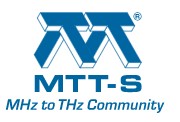Distinguished Women in Microwaves Event
Sunday, 19 January 2025, 7:00pm – 8:15pm
Organizer: Jasmin Grosinger, Graz University of Technology, Austria
The Women in Microwaves (WiM) event at the upcoming IEEE Radio & Wireless Week (RWW) 2025 will spotlight distinguished women who have advanced the field of microwave theory and technology considerably. Three outstanding women in microwaves will discuss their respective research fields and careers. A light reception will accompany the event, allowing us to network and connect. Dr. Sandra Cruz-Pol, ERC Program Director, National Science Foundation, Alexandria, VA, USA, will talk about RF Sensors for Remote Sensing the Earth and the Importance of RF Spectrum Management. Dr. Bernadette Smith, a Senior R&D Software Engineer at Keysight Technologies, USA, will detail Millimeter and Sub-THz Noise Figure and Noise Parameter Measurements for 6G. Prof. Ifana Mahbub from The University of Texas at Dallas, TX, USA, will dive deep into the Next Generation of Wireless Power Transfer Network of Unmanned Aircraft Systems.
RF Sensors for Remote Sensing the Earth and the Importance of RF Spectrum Management
Speaker: Sandra Cruz-Pol, NSF Engineering Division
Abstract
In this talk, I will review my research work in using satellite and ground-based microwave sensors to study the Earth. I will also talk about the ever-growing importance of radio regulations for efficiently sharing the radio spectrum among many users to minimize RFI and benefit society.
Bio
Dr. Sandra Cruz-Pol was born and raised in Puerto Rico. She received a Ph.D. in Electrical Engineering from Penn State University working with passive and active satellite and ground-based sensors studying atmospheric gases and the sea surface emissivity. She worked in active remote sensing at UMass for her MS degree. Her BS degree is from University of Puerto Rico at Mayagüez (UPRM). All three degrees were obtained with the Suma Cum Laude distinction. Before joining the NSF Engineering Division as a Program Director for the Engineering Research Centers (ERC) in 2018, she was a professor in the Electrical and Computer Engineering Department at UPRM since 1991. Her interests include microwave sensors, weather radars, and climate monitoring. She was a member of the U.S. National Academies (NAS) Committee on Radio Frequencies (CORF) from 2010-2019. She was also an appointed member of the NAS Active Spectrum Study. Before joining NSF as a permanent PD, she was an NSF rotator as a Spectrum Manager and the Program Director for the NSF EARS (Enhancing Access to the Radio Spectrum) program in 2014. She was appointed by NSF as a member of the U.S. Delegation for Spectrum Management to the U.N. International Telecommunications Union (ITU) in Geneva and was the NSF Representative for the Interdepartment Radio Advisory Committee (IRAC) at the U.S. National Telecommunications and Information Administration (NTIA) and for several subcommittees. She received the NASA Faculty Award for Research in 2002. Dr. Cruz-Pol is a Senior member of the IEEE. She was the Associate Editor for University Affairs for the IEEE GRSS Newsletter for five years.
Millimeter and Sub-THz Noise Figure and Noise Parameter Measurements for 6G
Speaker: Bernadette Smith, Keysight Technologies
Abstract
Accurate noise measurements play a critical role in component design and verification across various domains. Emerging technologies in 6G, remote sensing, and automotive radar, among others, require measurements in the millimeter and sub-THz range, and these measurements are often performed on-wafer. Reliable and accurate noise characterization becomes increasingly challenging, with difficulties surrounding instrumentation, calibration and correction, and measurement uncertainty. Key challenges will be discussed including the need for multi-tiered calibrations (especially relevant for on-wafer measurements or systems utilizing down-converters) and the requirement to manage source impedance deviation using impedance tuners. Other issues, including those surrounding temperature effects and on-wafer probing will also be addressed. State-of-the-art calibration and measurement techniques using the VNA-based cold source method will be presented along with a survey of commercially available accessories, including noise tuners, high-frequency switches, and low-noise amplifiers.
Bio
Dr. Bernadette Smith has a BS in Physics from the California Institute of Technology and a PhD in Physics from the University of Colorado at Boulder. Her PhD research concentrated on searches for supersymmetry at the Large Hadron Collider at The European Organization for Nuclear Research (CERN). Finding a new passion for instrumentation and measurement science, she pivoted careers and is now a Senior R&D Software Engineer at Keysight Technologies. She has been with Keysight Technologies since 2011, working primarily with vector network analyzers. She currently specializes in microwave and RF noise figure measurements, calibration and correction (including fixturing), and uncertainty analysis and has one patent in this area.
Next Generation of Wireless Power Transfer Network of Unmanned Aircraft Systems
Speaker: Ifana Mahbub, The University of Texas at Dallas
Abstract
This talk highlights the next generation of wireless power transfer (WPT) network concept that is scalable, safe, and efficient and can be deployed in a UAS by incorporating waveform engineering, electromechanical beamforming, integrated phased-array antenna, and transmitter (TX)/receiver (RX) co-design. Although interest in radiative (far-field) WPT using beamforming has been growing rapidly because of its capability to energize a large number of autonomous devices, most of these works are still in the theoretical phase without any practical implementation. This talk presents the implementation of a distributed beamforming network using a bottom-up approach (from the antenna to the inter-connected network) that is highly important for addressing the challenges associated with a dynamically changing environment. Practical system-level implementation strategies and multi-scale and multi-technique approaches to building a resilient WPT network for UAVs will be discussed. First, the challenges associated with the dual approach of electrical beamforming and the mechanical steering of the TX antennas to maximize the RF-RF link efficiency will be discussed. Secondly, an investigation of the efficient rectifier circuitry designed on-chip as well as commercial off-the-shelf components (COTS) to maximize the power conversion efficiency RF-DC efficiency will be presented. Finally, future research directions on increasing the power transfer distance to scale up the amount of power delivered to the load for the proposed wireless power beaming network system will be highlighted.
Bio
Prof. Ifana Mahbub is the director of the Integrated Biomedical Radiofrequency Circuits and Systems Laboratory (iBioRFCASL). Dr. Mahbub works on ultrawideband and mm-wave phased-array antenna systems for long-range power beaming applications and V2V (vehicle-to-vehicle) communication for UAVs (Unmanned Aerial Vehicles), focusing on the RF and microwave components and miniaturized antenna designs. Dr. Mahbub is the recipient of the NSF Career Award (2020), the DARPA Young Faculty Award (2021), and the DARPA Director’s Fellowship (2023). She received a B.Sc. degree (2012) in Electrical and Electronic Engineering from the Bangladesh University of Engineering and Technology and a Ph.D. degree (2017) in Electrical Engineering from the University of Tennessee, Knoxville. She is an Associate Editor for the IEEE Transactions on Antenna and Propagation. She is a senior member of various IEEE societies and serves as the IEEE Microwave Theory and Technology Society’s Region 5 coordinator of the Membership and Geographic Activities (MGA) Committee. She also serves as the vice-chair for the URSI Commission K and is a full member of Commission B.






